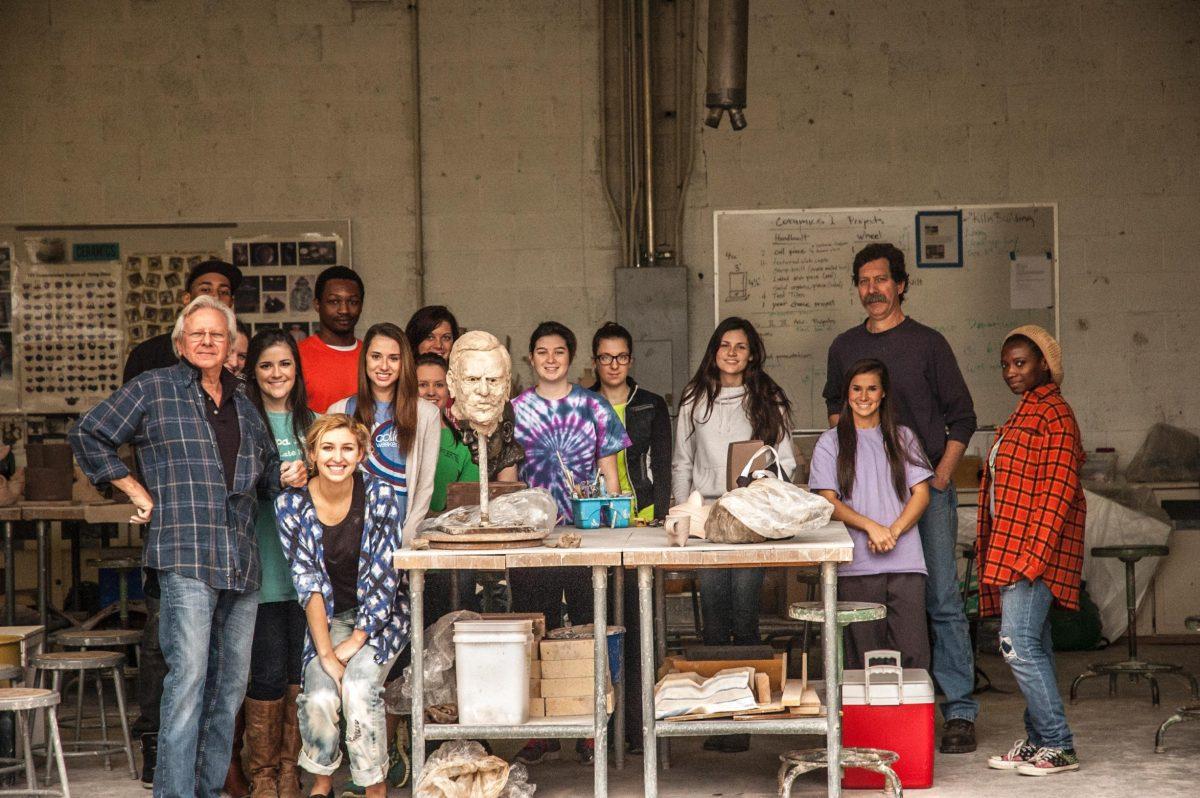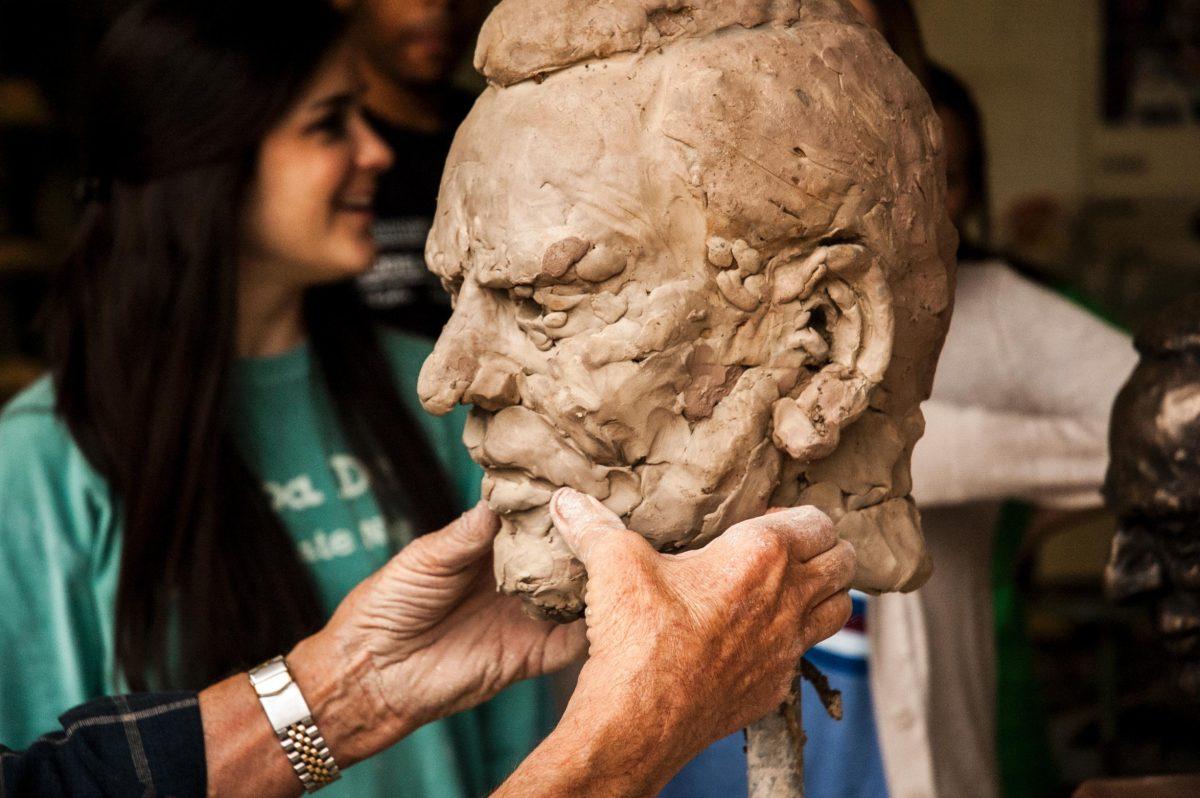Mississippi State University’s first artist-in-residence William “Bill” Dunlap is here to raise more questions than answers. He is by no means the mild-mannered artist type with a paint-smeared smock and a brush hanging from a shirt pocket. One minute (maybe less) in Dunlap’s exhibit at the Cullis Wade Depot Gallery, “Look At It – Think About It” clears up any preconceptions in the way a tornado clears a field: with Dunlap, confident presuppositions do not stand a chance.
Dunlap has extensive artist-in-residency experience and said he will be “test driving” the position here at MSU. Lori Neuenfeldt, programs coordinator for the Visual Arts Center Gallery and outreach programs, said the program is something of a laboratory in its trial run.
“Because we are doing this for the first time, you could say the MSU artist-in-residence is a scientist open to experimentation – someone who is creative and thinks outside the box to find ways to collaborate with students, faculty, staff and the Starkville community,” she said.
Neuenfeldt said Lydia Thompson, head of the Department of Art, noticed the impact Dunlap had on students during a visit to MSU last year and tossed his name into the pot as a possibility.
“I think the enthusiasm of our students and that of Dunlap fed off each other,” Neuenfeldt said. “Lydia noticed this and thought it was a perfect match.”
Thompson said the often informal, intimate way students interact with an artist-in-residence and observe his or her work is an invaluable element of artist-in-residency programs.
“He’s going to be in the studio where students can ask questions and observe his work process. That’s what’s really important. They (artists-in-residency) are actually making their work in the classroom where students can ask questions,” she said.
Dunlap’s residency allows students unfettered exposure to an artist of professional caliber, and Thompson said Dunlap also sets a precedent for what can be achieved with a Bachelor of Arts degree from Mississippi, the exact degree students are pursing.
“Bill Dunlap is a good role model in terms of demonstrating what you can actually do with a Bachelor of Fine Arts, and because he is from the state of Mississippi, he demonstrates the excellence the state offers,” she said.
Dunlap said one of his primary goals is to impart to students the idea of “a life in the arts” outside of paint-splattered college classrooms.
“It’s one thing to get the degree, to make good grades and do well in critiques, but I tell students that after that last critique, nobody gives a damn whether you make another painting, write another poem or make another photo,” he said. “You’ve got to make an audience for what you do. It’s not enough to make the work. You have to make the audience.”
Dunlap received a Bachelor of Science from Mississippi College and a Master of Fine Arts from the University of Mississippi. Although he is a proponent of the university system, he said he finds the importance of rules learned is the freedom to shatter them.
“To my mind, the only reason to learn the rules is to break them,” he said.
Dunlap conforms to no standards and seemingly never has. He said he’s the same kid he once was growing up in Webster County, Miss.
“I’m still that nine-year-old kid with a pocketful of arrowheads, marbles, Minnie balls, rabbits feet and an ever-present pocketknife,” he said.
His reputation as an exhilarating rush-of-a-person began as far back as his time at Mississippi College in the ’60s. In an on-campus painting demonstration last week with friend and well-known Mississippi watercolorist Wyatt Waters, both Mississippi College alumni, Dunlap reminisced on his exciting (and telling) relationship with the Baptist Student Union there.
“The BSU had a prayer list, and I managed to work my way to the top of it, but that was only because Barry Hannah graduated the year before I did,” he said with a laugh.
Dunlap has work exhibited in museums across the country, including the Metropolitan Museum of Art in New York, yet his dialogue and work remains peppered with Mississippi. In discussing “Red Gin and Walker Hound,” a painting of expansive fields populated by a proud bird dog, stoic red barn and white clapboard house, Dunlap said Mississippi, as both subject and influence, is inseparable from his work.
“I call what I do hypothetical realism. I couldn’t take you that place, but if you drove from here to Greenville on (Miss. Hwy) 82 and you hit the Delta, you’d see some of this,” he said.
The exhibit is a whirlwind. There are rural landscapes, stacks of New York Timesfrom the War on Terror, Rembrandt sporting a do-rag, even a decaying hawk’s foot. Nothing in Dunlap’s exhibit exists alone, and he said these compositions are deliberately experimental.
“I want them to have layers. I just put something next to something else and see what happens,” he said.
Dunlap said he gathers objects, often without knowing what will come of them, for instance, a shell-turned-helmet.
“I picked up this horseshoe crab shell in Martha’s Vineyard. I didn’t know what I was going to do with it,” he said. “I turned it into a fascist helmet, and it worked.”
Dunlap said he juxtaposes both fashioned and real objects in close proximity. Whether contrastingly or harmoniously, or somewhere in between, jars of locusts and bullet-holed deer skins interweave with paintings and drawings. A knife even stabs canvas in “Bad Dog,” a piece Dunlap said resulted due to one stubborn canine.
“This is a piece of self-criticism. That canvas didn’t behave, and I was painting this dog that insisted on being a cheetah, so in frustration, I took a tube of yellow paint and painted ‘bad dog,'” he said.
“Bad Dog” consists of an unfinished landscape of cracking paint depicting a red-roofed house, shed and three dogs; one of which, the aforementioned unlucky pup, is a lumpy figure covered with a vibrant yellow X and scribbled letters deeming him “Bad Dog.” Another wooden-framed painting of two seemingly violent dogs joins one end of the landscape, a knife stabs a white canvas attached in one corner and Dunlap’s old mailbox resting atop a rugged barn timber rests underneath.
“Bad Dog” is no exception: “Look At It – Think About It” is filled with unexpected fusions on every wall.
“He’ll Set Your Fields on Fire” is an amalgamation of snakeskin, wood, a human-like skull and a taxidermic bull squirrel whispering into an old microphone, perched above an unfinished “Get right with God” sign. All this riffs on and exists underneath what Dunlap said is a painting inspired by the burning fields of an old Christian tune.
“This is about an old Gospel song: ‘If from sin you don’t retire, He will set your fields on fire,'” he said. He indicated the bull squirrel and the sign: “This is one of those preachers on the radio,” he said. “I like the sign unfinished – it’s like some guy was working on it and God struck him with lightning. A lot of these things are unfinished.”
Dunlap said his work is intentionally stimulating, but he does not credit his tale of the paintings and constructions as inherently correct, singular meanings.
“That’s all I’m trying to do is literally be provocative. I don’t have one story. I can tell you my story, but if someone else’s story is different, I am very democratic about this,” he said. “I don’t insist that people see it one way or the other.”
Dunlap’s works and talks draw more tensions than resolutions. His provocations not only suggest, but require many questions; nothing is sacred. What it truly means to engage art, to be an artist, a Mississippian, a teacher, a student of the arts – Dunlap At calls these things into question through his juxtapositions, his talks and conversations. Dunlap wants (and causes) reconsideration of many things, and his work furnishes one overarching result: “Look It – Think About It” leaves its title as the single concrete answer Dunlap has brought with him.
Dunlap will be giving a walk-through of his work in “Look At It — Think About It” on Tuesday, Feb. 26.









